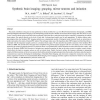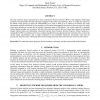40 search results - page 4 / 8 » Shape Analysis of Human Brain with Cognitive Disorders |
CVBIA
2005
Springer
14 years 1 months ago
2005
Springer
Segmentation of medical images is an important first step in the analysis of medical images. A lot of research has been performed on the segmentation of complex CT/MR images using...
NN
2000
Springer
13 years 7 months ago
2000
Springer
The article contributes to the quest to relate global data on brain and behavior (e.g. from PET, Positron Emission Tomography, and fMRI, functional Magnetic Resonance Imaging) to ...
HVEI
2009
13 years 5 months ago
2009
The data model for image representation in terms of projective Fourier transform (PFT) is well adapted to both image perspective transformations and the retinotopic mappings of th...
ISBI
2007
IEEE
14 years 2 months ago
2007
IEEE
Statistical shape analysis techniques commonly employed in the medical imaging community, such as Active Shape Models or Active Appearance Models, rely on Principal Component Anal...
UIST
2009
ACM
14 years 2 months ago
2009
ACM
Because functional near-infrared spectroscopy (fNIRS) eases many of the restrictions of other brain sensors, it has potential to open up new possibilities for HCI research. From o...


